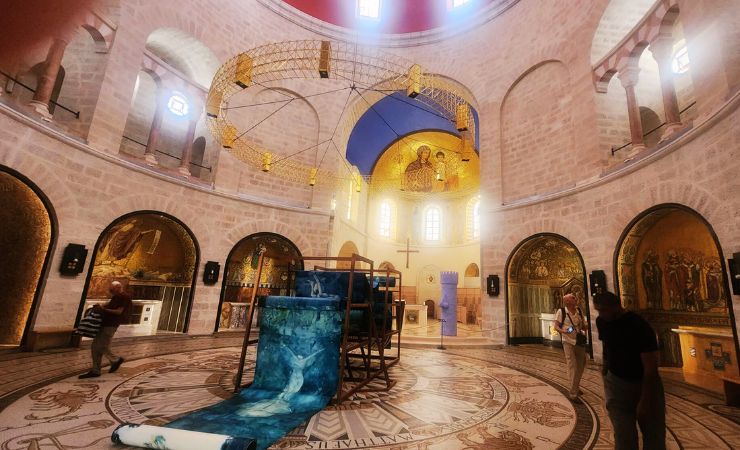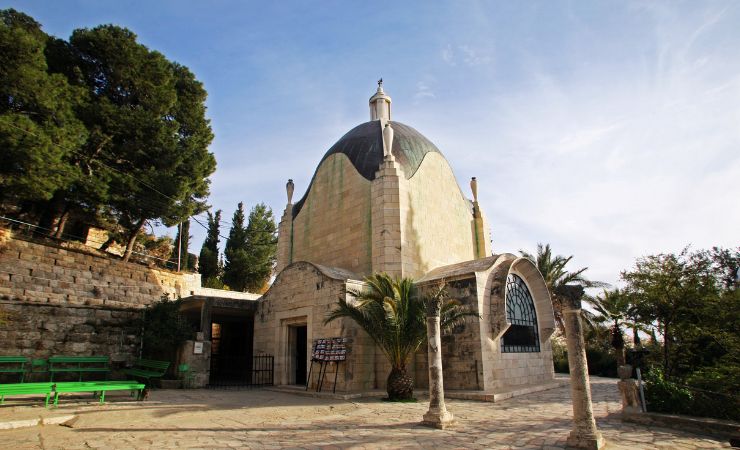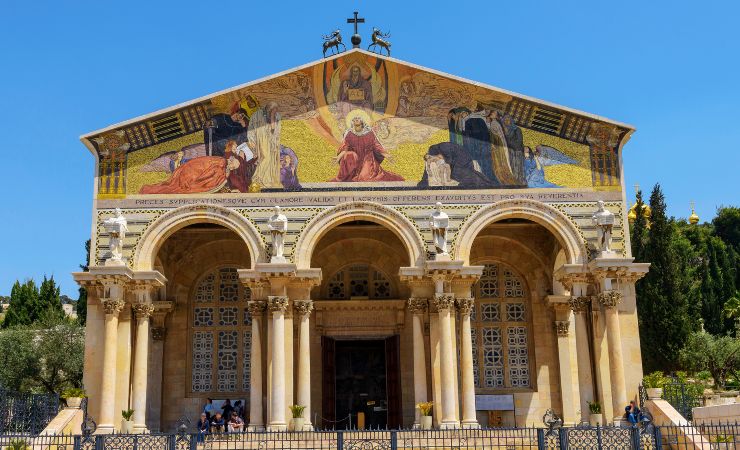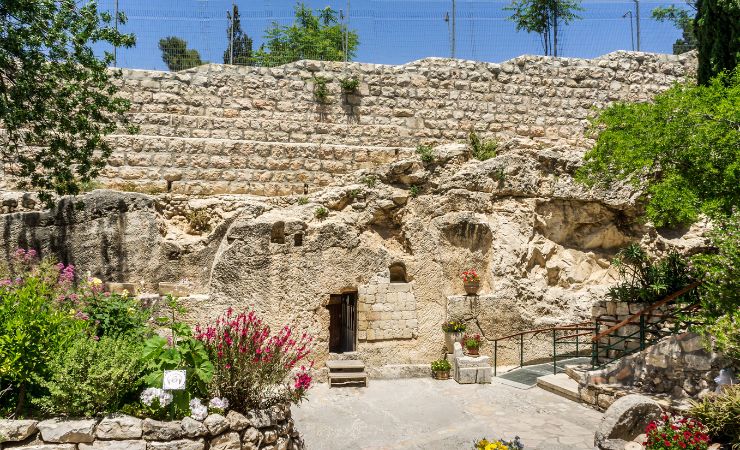The Serenity and History of Dormition Abbey in Jerusalem
Perched on the tranquil Mount Zion, the Dormition Abbey is a stunning church, with serene atmosphere and rich heritage.

Dormition Abbey Location
Dormition Abbey is located on Mount Zion, just outside the walls of the Old City of Jerusalem. It stands near the Zion Gate, making it easily accessible for visitors exploring the city’s ancient sites.
Biblical context
While the site itself is not directly mentioned in the Bible, it is traditionally believed to be the place where the Virgin Mary fell into eternal sleep, or “dormition,” before her assumption into heaven. This belief is rooted in early Christian traditions and apocryphal texts that describe Mary’s peaceful passing and her subsequent assumption. According to these traditions, Mary was surrounded by the apostles when she fell asleep, and her body was later taken up to heaven by Christ. This event is celebrated in the liturgy of the Dormition of the Theotokos, supported by references in early Christian writings like the “Protoevangelium of James.”



The Site's History
The history of Christian veneration on this site dates back centuries. In the early 5th century, a Byzantine basilica known as Hagia Sion was built here under John II, Bishop of Jerusalem. This church was destroyed during the Sasanian sack of Jerusalem in 614 CE. After remaining in ruins for a period, a new church was constructed by the Crusaders on the site of the earlier demolished Byzantine church in the 12th century. This Crusader church was also destroyed in the 13th century, and the site remained mostly unused and in ruins for approximately 500 years until the late 19th century.
The transformation began when German Kaiser Wilhelm II visited Jerusalem in 1898. He acquired the land on Mount Zion from Ottoman Sultan Abdul Hamid II for 120,000 German Goldmarks.
The cornerstone for the new Benedictine abbey was laid on October 7, 1900, marking the start of construction by German Benedictine monks.
The Dormition Abbey was designed by architect Heinrich Renard in an ecclesiastical, neo-Romanesque style. The present church building is circular with a large central dome and several niches containing altars and a choir. The exterior was modeled after the Worms Cathedral, and the interior was designed as a replica of Charlemagne’s palace chapel at Aix-la-Chapelle. The interior walls are adorned with inlaid mosaics depicting events from Christian history, as well as scenes from scripture, biblical figures, and Benedictine tradition.
The basilica was dedicated on April 10, 1910.
Dormition Abbey's Architecture
The Dormition Abbey’s architecture is a stunning blend of Romanesque and Byzantine styles, designed to evoke both spiritual contemplation and historical grandeur:
- Overall Design: The Abbey is a circular building featuring a large central dome and several smaller niches containing altars and a choir. This design was orchestrated by the German architect Heinrich Renard.
- Interior Mosaics: The floor mosaics of the upper church, designed in 1932, depict a creation story centered around the light of God, carried into the world by prophets, apostles, and evangelists. The mosaic includes the twelve signs of the zodiac, a unique feature for a Christian church.
- Crypt: The crypt, accessible via spiral staircases, houses a life-size sculpture of the Virgin Mary in her final slumber. The dome above features a mosaic of prominent women from the Bible, and surrounding chapels are dedicated by various countries.
- Bell Tower: Offers a panoramic view of Jerusalem, including the Old City and the Mount of Olives. The tower’s balcony and dome are notable features of the Abbey’s skyline.
Additional Information
- 1st Century CE: Early Christian traditions place the death (“Dormition”) of the Virgin Mary in Jerusalem, specifically at a site on Mount Zion. Some traditions also associate the Last Supper with Mount Zion.
- Early 5th Century CE: A basilica named Hagia Sion is established on Mount Zion, marking the traditional spot of Mary’s Dormition.
- 5th Century CE: A Late Antiquity wall is constructed around Jerusalem. Excavations indicate a more massive wall surpasses its defensive capabilities.
- Late 5th Century CE: More traditions regarding the Dormition of Mary begin to circulate in manuscripts, including the “Palm of the Tree of Life,” “Bethlehem,” and “Coptic” narratives. Anonymous traditions concerning the Dormition date back as early as the 3rd century or even earlier.
- Around the time of Emperor Maurice (582-602 CE): Emperor Maurice issues an edict setting the date for the celebration of the Dormition on August 15.
- 7th Century CE: Modestus, Patriarch of Jerusalem (630-632 CE), preaches at the Dormition celebration and notes the lack of specific information about Mary’s death.
- 12th Century CE: A monastic order known as the Abbey of Our Lady of Mount Zion is established at the site of the ruined Byzantine church. A new church is built.
- 13th Century CE: The 12th-century Crusader church on Mount Zion is destroyed. The monks move to Sicily.
- 16th Century CE: The Monastery of the Holy Cross comes into the possession of the Greek Orthodox Patriarchate.
- 1617 CE: The Abbey of Our Lady of Mount Zion order is absorbed into the Jesuits.
- 1898: German Kaiser Wilhelm II visits Jerusalem for the dedication of the Lutheran Church of the Redeemer. He purchases land on Mount Zion from Sultan Abdul Hamid II for 120,000 German Goldmark and presents it to the “German Association of the Holy Land” to build a Catholic church. Frederick Bliss and Archibald Dickie conducted excavations in Jerusalem, including on Mount Zion.
- 1900: The cornerstone for the Dormition Abbey is laid on October 7th. The construction design is entrusted to Heinrich Renard, and the direction of construction to Theodor Sandel.
- 1901-1910: The Dormition Abbey is constructed.
- 1906: The cornerstone laying ceremony for the Dormition Abbey is held in March. The first Benedictine monks are sent to Jerusalem from Beuron Archabbey in Germany.
- 1910: Construction of the Dormition Abbey is completed. The basilica is dedicated on April 10th by the Latin Patriarch of Jerusalem.
- 1918–1921: The German monks from Dormition Abbey are interned for the first time after the end of World War I.
- 1926: The monastery at Dormition Abbey is raised to the status of an abbey within the Beuron Congregation.
- 1939–1945: The German monks are interned for the second time during World War II.
- 1948: During the Arab-Israeli War, Dormition Abbey is damaged by shelling. The German monks are interned for the third time. The abbey is located in Israeli-controlled territory on Mount Zion, across from Jordanian-controlled territory.
- 1979: The Benedictine community at Dormition Abbey elects its own abbot for the first time.
- 1998–2006: The community at Dormition Abbey is known as the Abbey of Hagia Maria Sion.
- 2006: During the monastery’s centenary celebrations, the abbey resumes its original name, Dormition Abbey. “Hagia Maria Sion” becomes the name of the supporting foundation.
- January 2016: Vandals write anti-Christian slogans on the walls of Dormition Abbey.
Nearby Sites
- King David’s Tomb: Believed to be the burial place of the biblical King David, located just a short walk from Dormition Abbey.
- The Cenacle (Room of the Last Supper): The traditional site of Jesus’ Last Supper with his disciples, situated on the same mount.
- Church of St. Peter in Gallicantu: A stunning church marking the site of Peter’s denial of Jesus, offering breathtaking views and historical insights.
- The Old City of Jerusalem: Just a stone’s throw away, with its myriad of historical, religious, and cultural sites, including the Western Wall, the Roman Cardo, Church of the Holy Sepulchre, and the Dome of the Rock.



